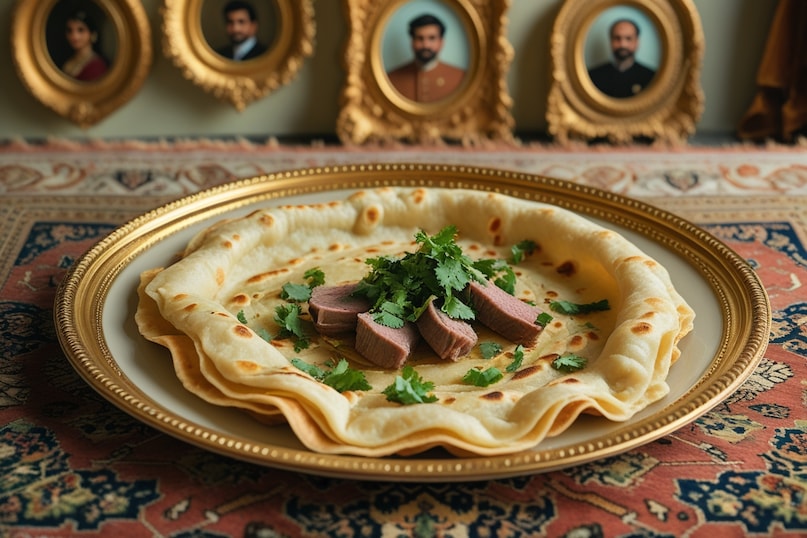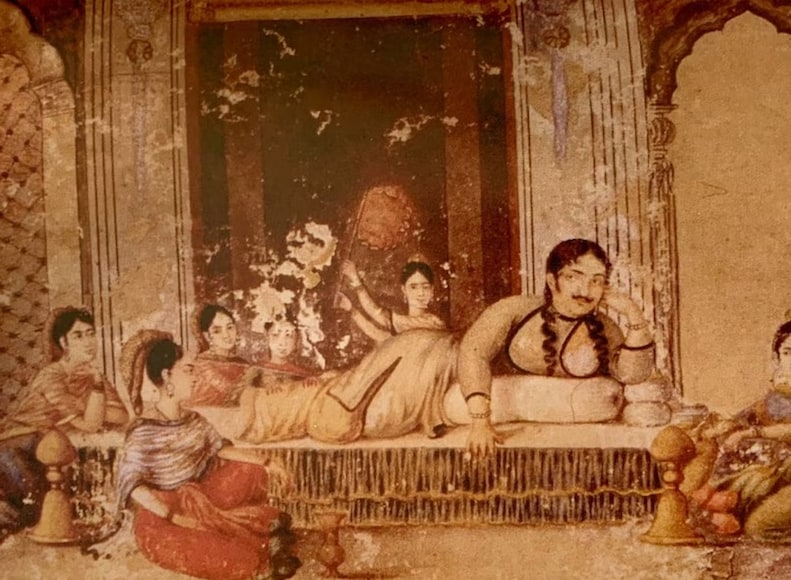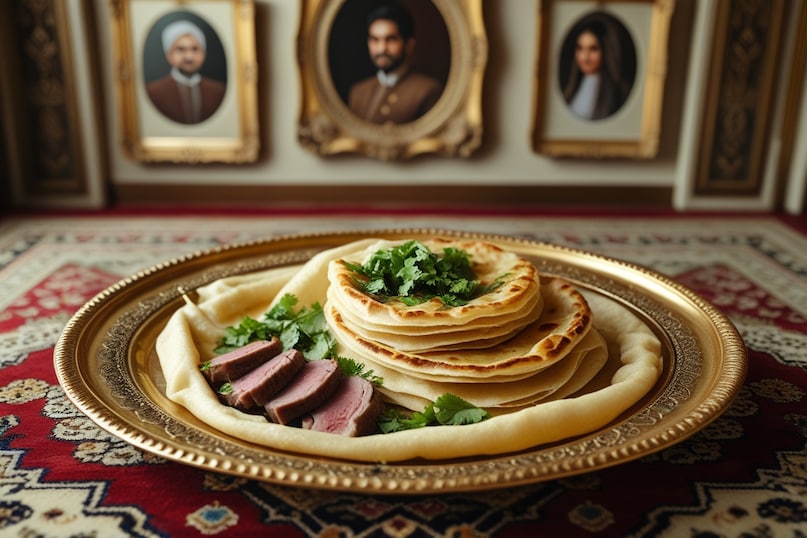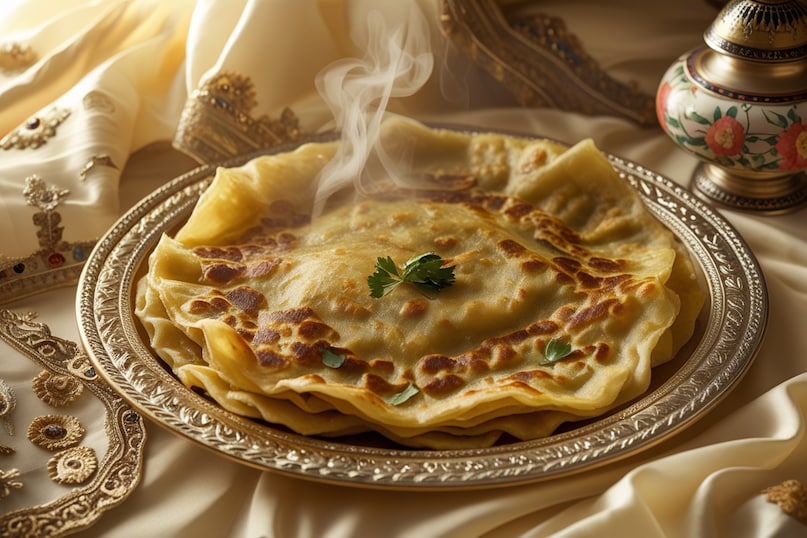Velvet roti named her velvet and exactly fine silk layers like velvet. It was neither a common tandoori roti, nor a tawa paratha, but a fine -in -floor and little muslin like fine -in -thewest layer. The dough used to be kneaded by mixing eggs, sometimes cream or milk. In ghee or butter, it was cooked on a low flame or on a low flame.
So thin that the other side is peeping
The thickness of the bread was so thin that the part of the other side used to peeping lightly, so soft that even the fingers were torn. It was special that it would dissolve as soon as it goes into the mouth. Every person’s scent of ghee, saffron, kevra, rose water.
Wajid Ali Shah’s cook
Most historians and Dastarkhwan Researchers consider it to be the desire of the Nawab Wajid Ali Shah of Awadh (Lucknow). Some forms of this are also seen in the Dastarkhwan of the Begums of Patiala and Bhopal. Before knowing more about this roti, know the three stories called it.

Image generated by leonardo ai
Story 1 – Nawab Wajid Ali Shah and Velvet Roti
It is said that Awadh’s Nawab Wajid Ali Shah was as fond of eating food as much as it was. Once the Nawab Saheb said to his special cook, “O Haji Mian! Bring some bread, which is seen, if you see a sheet of velvet and eat it, then it dissolves in the mouth.”
Haji Mian thought a lot. Tandoor Roti, Tawa Paratha, Taataan, Sheeramal were all formed. Then for the first time he kneaded flour by adding cream, milk, kevra and saffron. Made very fine layers, applied ghee and arrowroot in the middle. Then it was slowly baked and introduced.

Wajid Ali Shah was fond of eating brilliant food and decorating the festivals.
Story 2- Maharaja and Velvet Paratha of Patiala
Maharaja Bhupinder Singh was known for his heavy parathas. One day the Maharaja, who returned from Nawabi Dastarkhan of Lucknow, said,
“We also need such a paratha which is velvet. It is not even cut off the knife.”
The royal cook Rasul kitchen of Patiala made a lot of efforts. Mixed a velvet paratha by mixing paste of maida, cream, saffron, almond-pistachios.
He was so soft and ghee that the Maharaja ate and said, “Today I felt like bread, not eating velvet.” From that day onwards, every celebration was made in the Maharaja’s Dastarkhwan and a velvet paratha in Mushaira. Whenever a guest came to eat, he would definitely be presented a velvet paratha.
Story 3 – Begum Sultana Jahan Ka Dastarkhan (Bhopal)
Begum Sultana Jahan of Bhopal once said in a Mushaira, “Today you want a bread that is soft like Mehboob’s sluggish.” On his request, for the first time, for the first time, the dough with eggs, cream and kevada made velvet bread. It is said that that night there was more velvet roti than poetry in the entire Mushaira.

Image generated by leonardo ai
Is such a velvet bread now made somewhere
The real velvet bread is now almost endangered. However, some forms close to this are still found in the old Kabbi Mohallas of Lucknow, in the streets behind the Charminar in Hyderabad and in Ibrahimpura in Bhopal. Now people have started calling it ‘muslin paratha’ or ‘silk roti’, but like real velvet bread, texture and smell are now equal.
A few selected hotels like Imperial Delhi, Taj Lucknow and Falaknuma Hyderabad present its modern form in their ‘Royal Awadhi Thali’, but they are not like the origin. It was said in Awadh,
“Velvet roti, which does not be cut with a knife even with kebabs, but dissolves on the tongue.”
That is, it is difficult to handle such a softness, not with a knife, but also with fingers.

Image generated by leonardo ai of velvet paratha
What used to be velvet paratha
On hearing the name ‘velvet paratha’, a magnificent paratha glowing with silk soft layers with silk soft layers in the mind comes in Tassavur. In fact, the velvet paratha is a very unique and lost dish of Indian royal kitchens, especially mentioned in the courtiers of Patiala, Awadh, and Hyderabad.
It fell due to a soft texture and taste like velvet, that is, velvet. It was completely different from the common paratha. Finely layers. Ghee was baked very slowly and was prepared especially in almonds, pistachios, kevda, and saffron paste.
Dried dry fruits or mince
Fine flour and a little arrowroot were added to this paratha flour so that the layers become very fine and soft. Cleaning with ghee and rolling it on low heat, so that its texture would become exactly like silk velvet. Sometimes mawa (khoya), dry fruits, or minced were also filled in the middle of the paratha. Before serving it, rose water, Kevada water or saffron extracts were sprinkled.
Royal kebabs were served with Nihari
It was kept in a silver plate. Sometimes gold and silver work was also planted on it. It was served with royal kebabs, Nihari or Dum-e-Patiala. It was served in the court of Patiala, especially during the night banquet in winter. The royal was also part of the royal Dastarkhwan in the Nawabi era of Lucknow. Later, in some forms, it was also made in sweet flavor like Sheermal in the kitchen of Hyderabad.
It is said that when Maharaja Bhupinder Singh of Patiala had to keep a special party for his British guests, he would definitely make ‘velvet paratha’. Once an English general ate it and said, “This is more soft than my wife’s hand.”



